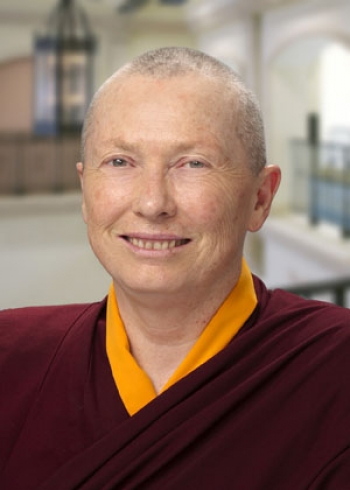B: One of the conference topics was “Is there a Feminine Dharma?”. This question is far more loaded than the usual question about nuns or laywomen. It assumes that the Dharma has a feminine aspect, and any conception of Dharma as having any gendered aspect might seem perplexing to an orthodox vision. Can you elaborate more about this?
KLT: The question “Is there a feminine Dharma?” is loaded, but it’s worth exploring. Do women and men approach Buddhist practice differently? The papers presented on this topic made it clear that Dharma practice and attainments are open to all, regardless of gender. The basic nature of the mind is not different for men and for women. The potential to purify the mind is not different for men and for women, at least in theory. But it was also clear from the ensuing discussions that the circumstances for realizing the human potential for enlightenment are very different for men and for women. Women still do most of the work in their homes and fields, and have greater household responsibilities, and generally have less time for formal Dharma practice. Women have far fewer opportunities for Buddhist education and training, so their potential for liberation is clearly circumscribed. How can women get access to the tools for liberation – the instructions and conditions for practicing on the path – if they cannot read, have no books, have no access to teachers, if teachers are not free to teach women, if their work schedules and domestic duties leave them little time for learning about the Dharma? How can women realize their potential for awakening if they do not have equal access to monastic life? How can they develop the confidence to strive for liberation if they are taught from early childhood that the very body they occupy is a result of their bad karma? How can somen gain the confidence they need to strive diligently when their teachers say that women’s path to higher ordination is blocked? These are the challenges that Buddhist women face today.
All of these problems can be remedied fairly easily, if there is greater awareness and the will to do so. If women approach the understanding of Dharma differently and forge new approaches to practice, this may be a strength. At the conference in Vaishali, the Tara Dancers illustrated this in their innovative and empowering approach to learning Dharma through movement. Given equal education and opportunity, it is likely that women will contribute fresh insights, including practical ways of integrating Dharma in daily life, for example, the ethical development of children, healthy approaches to caregiving, and compassionate means of social service. Women can help expand the concept of intensive practice beyond the monastic limits imposed by certain traditions, providing greater affirmation of lay practice. Women may put their communications skills to work, developing new, more accessible ways of expressing the Dharma. They may put their organizational skills to work, developing more egalitarian structures for Buddhist and other institutions.
KLT: The question “Is there a feminine Dharma?” is loaded, but it’s worth exploring. Do women and men approach Buddhist practice differently? The papers presented on this topic made it clear that Dharma practice and attainments are open to all, regardless of gender. The basic nature of the mind is not different for men and for women. The potential to purify the mind is not different for men and for women, at least in theory. But it was also clear from the ensuing discussions that the circumstances for realizing the human potential for enlightenment are very different for men and for women. Women still do most of the work in their homes and fields, and have greater household responsibilities, and generally have less time for formal Dharma practice. Women have far fewer opportunities for Buddhist education and training, so their potential for liberation is clearly circumscribed. How can women get access to the tools for liberation – the instructions and conditions for practicing on the path – if they cannot read, have no books, have no access to teachers, if teachers are not free to teach women, if their work schedules and domestic duties leave them little time for learning about the Dharma? How can women realize their potential for awakening if they do not have equal access to monastic life? How can they develop the confidence to strive for liberation if they are taught from early childhood that the very body they occupy is a result of their bad karma? How can somen gain the confidence they need to strive diligently when their teachers say that women’s path to higher ordination is blocked? These are the challenges that Buddhist women face today.
All of these problems can be remedied fairly easily, if there is greater awareness and the will to do so. If women approach the understanding of Dharma differently and forge new approaches to practice, this may be a strength. At the conference in Vaishali, the Tara Dancers illustrated this in their innovative and empowering approach to learning Dharma through movement. Given equal education and opportunity, it is likely that women will contribute fresh insights, including practical ways of integrating Dharma in daily life, for example, the ethical development of children, healthy approaches to caregiving, and compassionate means of social service. Women can help expand the concept of intensive practice beyond the monastic limits imposed by certain traditions, providing greater affirmation of lay practice. Women may put their communications skills to work, developing new, more accessible ways of expressing the Dharma. They may put their organizational skills to work, developing more egalitarian structures for Buddhist and other institutions.















